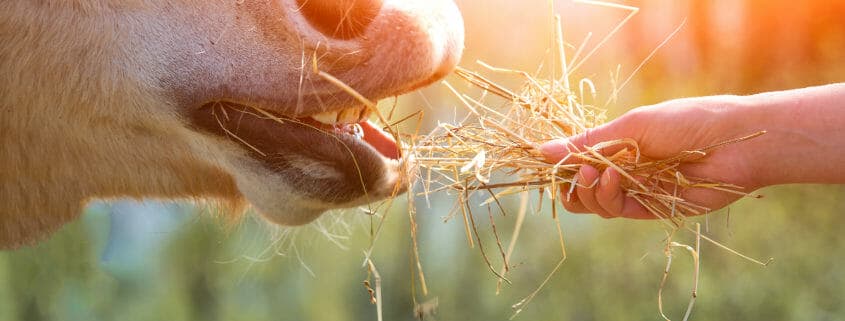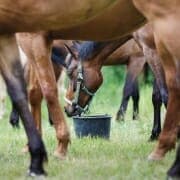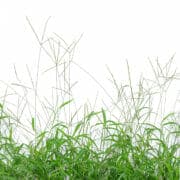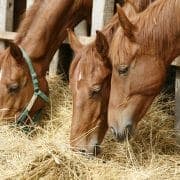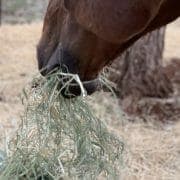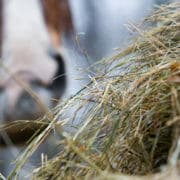Teff Hay for Laminitic Horses
Over the last few years questions about teff (Eragrostis tef) hay and its suitability for laminitic horses have started to come up and it appears production of teff hay and therefore availability is on the rise. Here is a very mini review of the published research on teff hay in horses that we can find:
Recent Research on Teff Hay for Horses
Staniar et al 2010
These authors report non-structural carbohydrate (NSC) contents for teff of 5.4% in the ‘boot’ stage and 8.4% in the ‘late heading stage’ of plant maturity. Both really low NSC levels and well below the 10 – 12% threshold considered safe for laminitic horses. Variation between samples was also minimal which is also our experience with other C4 Type grasses like Rhodes for example.
Horses in this study ate 1.5% to 1.8% of their bodyweight in teff hay, with the lower intakes being on the more mature hay. Again, this is a good thing as horses on restricted diets are unlikely to eat this hay as fast as more palatable hays like alfalfa, so they should eat for longer periods of time for lower calorie intake.
McCown et al 2012
Report that when fed to horses unaccustomed to teff and given a choice of either teff and alfalfa or teff and timothy, their intake of teff is lower than their intake of alfalfa (no surprises there) and timothy. BUT, when given access to only teff, intake was about the same as timothy hay. So they don’t relish teff hay, but truly, this is a good thing as they are less likely to overeat it!
Askins et al 2017
These authors report that horses given free access to teff hay consumed 1.5% of their bodyweight per day which equated to 86% of maintenance calorie requirements. So the finding of lower intake on teff continues … hooray for teff!
This study also reports that resting glucose and insulin levels did not change over 10 days while the horses were fed teff. To keep this in context however, ryegrass hay (which can be very high in NSC) was fed as the control hay in this study and glucose and insulin levels also remained the same on this hay. Unfortunately, the NSC content of the hays was not reported (yet!).
DeBoer et al 2017
In another recent study, these authors report that cool season (C3) perennial grasses (in this case orchardgrass, also known as cocksfoot and Kentucky bluegrass) had a significantly higher NSC content than teff pasture in summer and fall/autumn, however actual NSC content was not reported (this is just an abstract, hopefully the data will be fully published in future).
This research also looked at differences in plasma glucose levels in horses grazing either alfalfa, cool season (C3) grasses or teff and found that differences were minimal. However, we know that insulin resistant horses can maintain normal glucose levels, they just need a lot more insulin to achieve this. So just because differences in glucose levels were not apparent doesn’t mean there would not have been differences in insulin levels. These authors report that insulin levels will be reported in future research, so hopefully it is just a case of ‘watch this space’.
Summary
All in all, from the research available, teff appears to be suitable for laminitic horses and any other horses who need either a calorie restricted and/or NSC restricted diet. If you are going to feed teff hay, though be sure to use FeedXL to balance the diet.
Teff, being a subtropical/warm season/C4 type grass does contain oxalate which will reduce calcium absorption by your horse and may lead to calcium deficiency if you don’t correctly balance the diets calcium to oxalate ratio (FeedXL will make sure you do this!). Teff, like almost all forages will also be low in trace-minerals and doesn’t contain great quality protein… so you will have a few gaps to fill. Of course, testing your specific hay and uploading this to FeedXL will give you the best results in balancing your horse’s diet!
Finally, alfalfa/lucerne hay makes a great forage to feed alongside teff. Alfalfa is similarly low in NSC, but unlike teff is rich in quality protein and high in calcium to help offset the calcium binding tendency of the teff. They complement each other nicely.
If you need a low NSC forage, teff gets the thumbs up from us!
If you have a laminitic horse, be sure to read our blog: Feeding the Laminitic Horse
REFERENCES
Askins M.J., Palkovic A.G., Leppo K.A., Jones G.C. & Gill J.C. Effect of feeding teff hay on dry matter intake, digestible energy intake and resting insulin/glucose concentration in horses. Journal of Equine Veterinary Science 52, 45.
DeBoer M.L., Hathaway M.R., Kuhle K.J., Weber P.S.D., Sheaffer C.C., Wells M.S., Mottet R.S. & Martinson K.L. Glucose response of horses grazing alfalfa, cool-season perennial grasses and teff across seasons. Journal of Equine Veterinary Science 52, 79.
McCown S., Brummer M., Hayes S., Olson G., Smith S.R., Jr. & Lawrence L. Acceptability of Teff Hay by Horses. Journal of Equine Veterinary Science 32, 327-31.
Staniar W.B., Bussard J.R., Repard N.M., Hall M.H. & Burk A.O. (2010) Voluntary intake and digestibility of teff hay fed to horses1. J Anim Sci 88, 3296-303.
Do you have a question or comment? Do you need help with feeding?
We would love to welcome you to our FeedXL Horse Nutrition Facebook Group. Ask questions and have them answered by PhD and Masters qualified equine nutritionists and spend time with like-minded horse owners. It’s free!
Click here to join the FeedXL Horse Nutrition Facebook Group

